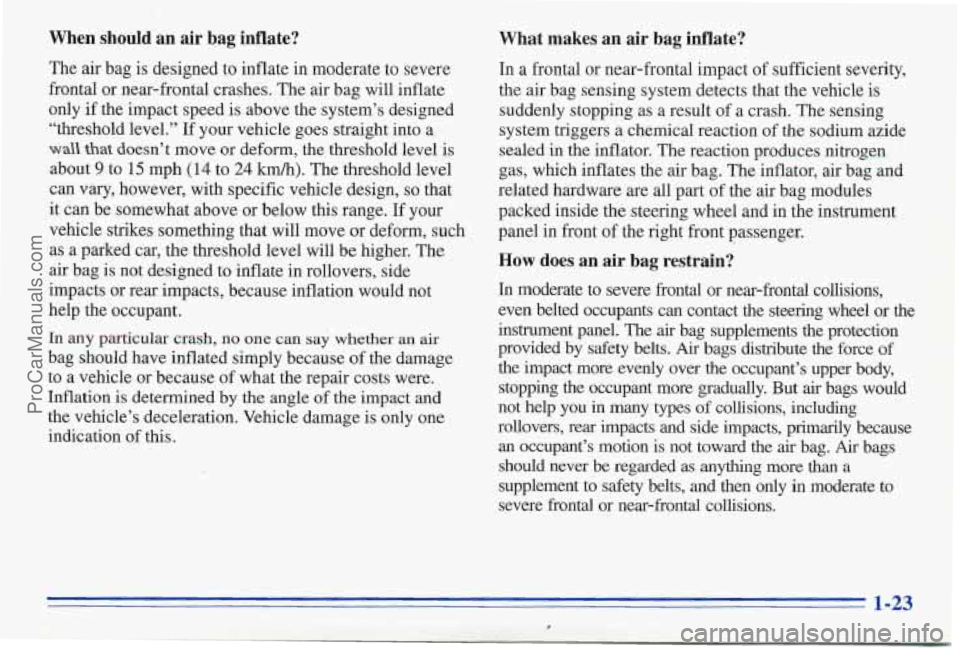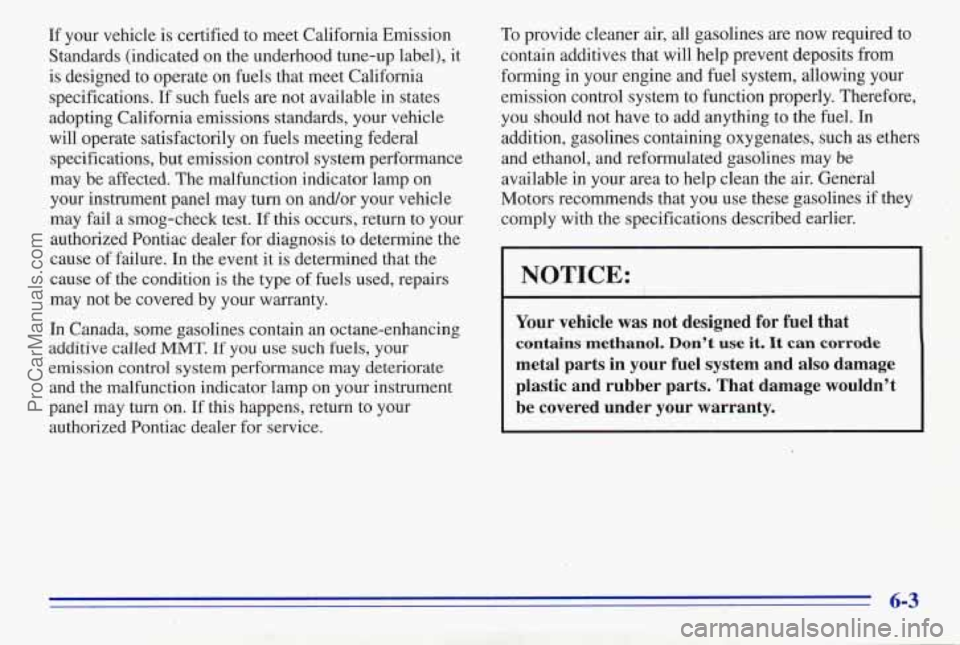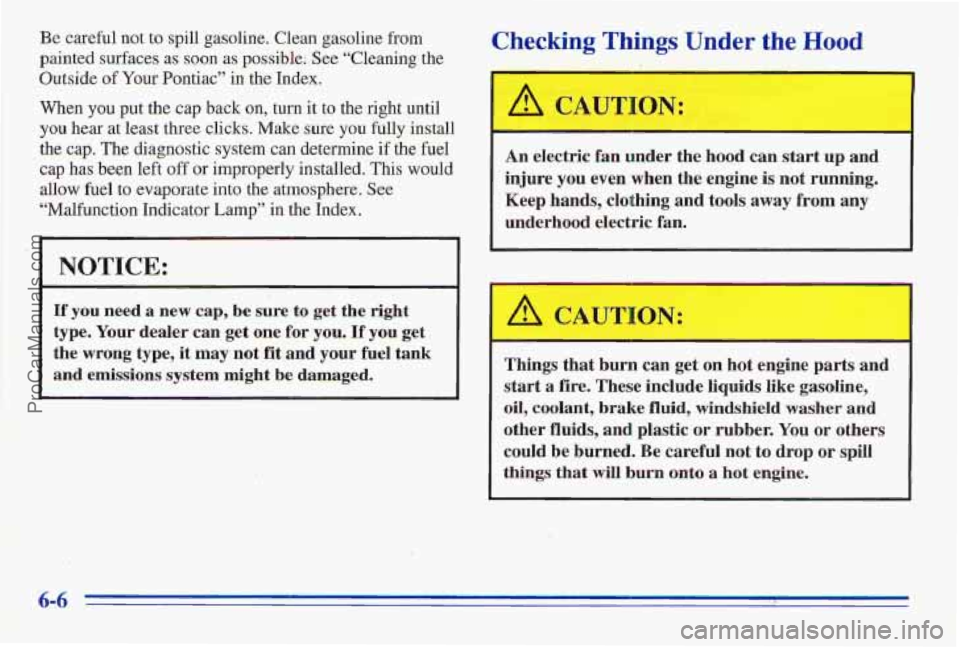gas type PONTIAC FIREBIRD 1996 Owners Manual
[x] Cancel search | Manufacturer: PONTIAC, Model Year: 1996, Model line: FIREBIRD, Model: PONTIAC FIREBIRD 1996Pages: 386, PDF Size: 19.18 MB
Page 30 of 386

When should an air bag inflate?
The air bag is designed to inflate in moderate to severe
frontal or near-frontal crashes. The air bag will inflate
only
if the impact speed is above the system’s designed
“threshold level.”
If your vehicle goes straight into a
wall that doesn’t move or deform, the threshold level is
about 9 to 15 mph (14 to 24 km/h). The threshold level
can
vary, however, with specific vehicle design, so that
it can be somewhat above or below this range. If your
vehicle strikes something that will move or deform, such
as
a parked car, the threshold level will be higher. The
air bag is not designed
to inflate in rollovers, side
impacts or rear impacts, because inflation would not
help the occupant.
In any particular crash, no one can say whether an air
bag should have inflated simply because of the damage
to a vehicle or because
of what the repair costs were.
Inflation is determined by the angle
of the impact and
the vehicle’s deceleration. Vehicle damage
is only one
indication
of this.
What makes an air bag inflate?
In a frontal or near-frontal impact of sufficient severity,
the air bag sensing system detects that the vehicle
is
suddenly stopping as a result of a crash. The sensing
system triggers
a chemical reaction of the sodium azide
sealed in the inflator. The reaction produces nitrogen
gas, which inflates the air bag. The inflator, air bag and
related hardware are all part
of the air bag modules
packed inside the steering wheel and
in the instrument
panel in front of the right front passenger.
How does an air bag restrain?
In moderate to severe frontal or near-frontal collisions,
even belted occupants can contact the steering wheel
or the
instrument panel. The
air bag supplements the protection
provided by
safety belts. Air bags distribute the force of
the impact more evenly over the occupant’s upper body, stopping the occupant more gradually. But
air bags would
not help you in many types
of collisions, including
rollovers, rear impacts and side impacts, primarily because an occupant’s motion is not toward the
air bag. Air bags
should never be regarded
as anythmg more than a
supplement to safety belts, and then only in moderate to
severe frontal or near-frontal collisions.
1-23
ProCarManuals.com
Page 58 of 386

To replace the battery in the Remote Lock
Control transmitter:
1. Carefully pry off the cover by inserting a dime (or
2. Lift off the back cover.
3. Remove and replace the battery. Use one battery,
similar object) in a slot between the covers and twist.
type CR2032, or a similar type. Put new battery in
printed side down.
4. Replace the back cover. Make sure the cover is on
tightly
so water won’t get in.
5. Check the trans,mitter operation. If the transmitter
does not work after battery replacement, it may need
to be resynchronized or matched to your vehicle. See
“Synchronization” in the Index.
It can be dangerous to drive with the hatch open
because carbon monoxide (CO) gas can come into
your vehicle. You can’t see or smell
CO. It can
cause unconsciousness
and even death.
If you must drive with the hatch open or if
electrical wiring or other cable connections
must pass through the seal between the body and
the hatch:
Make sure all windows are shut.
Wrn the fan on your heating or cooling
system to its highest speed with the setting
on
VENT. That will force outside air into
your vehicle. See “Comfort Controls” in
the Index.
instrument panel, open them all
the way.
If you have air outlets on or under the
See “Engine Exhaust” in the Index.
,ye*: ; -2
ProCarManuals.com
Page 244 of 386

If your vehicle is certified to meet California Emission
Standards (indicated on the underhood tune-up label), it
is designed to operate on fuels that meet California
specifications.
If such fuels are not available in states
adopting California emissions standards, your vehicle
will operate satisfactorily on fuels meeting federal
specifications, but emission control system performance
may be affected. The malfunction indicator lamp
on
your instrument panel may turn on and/or your vehicle
may fail a smog-check test. If this occurs, return to your
authorized Pontiac dealer for diagnosis to determine the
cause of failure. In the event it is determined that the
cause of the condition is the type
of fuels used, repairs
may not be covered by your warranty.
In Canada, some gasolines contain an octane-enhancing
additive called
MMT. If you use such fuels, your
emission control system performance may deteriorate and the malfunction indicator lamp on your instrument
panel may
turn on. If this happens, return to your
authorized Pontiac dealer for service.
To provide cleaner air, all gasolines are now required to
contain additives that will help prevent deposits from
forming in your engine and fuel system, allowing your
emission control system to function properly. Therefme,
you should not have to add anything to
the fuel. In
addition, gasolines containing oxygenates, such as ethers
and ethanol, and reformulated gasolines may
be
available in your area to help clean the air. General
Motors recommends that you use these gasolines
if they
comply with the specifications described earlier.
NOTICE: I
Your vehicle was not designed for fuel that
contains methanol. Don’t use it. It can corrode
metal parts in your fuel system and also damage
plastic and rubber parts. That damage wouldn’t
be covered under your warranty.
6-3
ProCarManuals.com
Page 247 of 386

Be careful not to spill gasoline. Clean gasoline from
painted surfaces as soon as possible! See “Cleaning the
Outside
of Your Pontiac” in the Index.
When
you plat the cap back on, turn it to the right until
you hear at least three clicks. Make sure you fully install
the cap. The diagnostic system can determine if the fuel
cap
has been left of or improperly installed. This would
allow fuel to evaporate into
the atmosphere. See
“Malfunction Indicator
Lamp” in the Index.
NOTICE:
If you need a new cap, be sure to get the right
type. Your dealer can get one for you, If you get
the
wrong type, it may not fit and your fuel tank
and emissions system might
be damaged.
.j
Checking Things Und-- the Hoop
An electric fan under the hood can start up and
injure you even when the engine is not running.
Keep hands, clothing and tools away
from any
underhood electric fan.
Things that burn can get on hot engine
parts and
start a fire. These include liquids like gasoline,
oil,
coolant, brake fluid, windshield washer and
other fluids, and plastic or rubber. You or others
could be burned. Be careful not to drop or spill
things
that will burn onto a hot engine.
6-6 .:
ProCarManuals.com
Page 278 of 386

Battery
Every new Pontiac has a Delco Freedom@ battery. You
never have to add water to one of these. When it’s time
for a new battery, we recommend a Delco Freedom
battery. Get one that has the replacement number shown
on the original battery’s label.
Vehicle Storage
If you’re not going to drive your vehicle for 25 days or
more, take off the black, negative (-) cable fiom the battery.
This will help keep your battery fiom running down. Contact your dealer to learn how to prepare your vehicle
for longer storage periods.
Also, for your audio system, see “Theft-Deterrent
Feature” in
the Index.
Bulb Replacement
For the proper type of replacement bulb, see
“Replacement Bulbs” ‘in
the Index.
Halogen Bulbs
/I CAUTION:
Batteries have acid that can burn you and gas
that can explode. You’can be badly hurt if you
aren’t careful. See 66Jump Starting”
in the Index
for tips on working around a battery without
getting hurt.
Ibs ha presr
can burst if you drop or scratch the bulb. You or
others could be injured. Take special care when
handling and
disposing of halogen bulbs. 1
6-37
ProCarManuals.com
Page 294 of 386

Appearance Care
Remember, cleaning products can be hazardous. Some
are toxic. Others can burst into flame if you strike a
match or get them on a hot part of the vehicle. Some are
dangerous
if you breathe their fumes in a closed space.
When you use anything from a container to clean your
Pontiac, be sure
to follow the manufacturer’s warnings
and instructions. And always open your doors or
windows when you’re cleaning the inside.
Never use these to clean your vehicle:
. Gasoline
Benzene
Naphtha
0 Carbon Tetrachloride
Acetone
0 Paint Thinner
Turpentine
0 Lacquer Thinner
0 Nail Polish Remover
They can all be hazardous -- some more than
others
-- and they can all damage your vehicle, too. Don’t use any of these unless this manual says you can.
In many uses, these will damage your vehicle:
0 Alcohol
Laundry Soap
Bleach
0 Reducing Agents
Cleaning the Inside of Your Pontiac
Use a vacuum cleaner often to get rid
of dust and loose
dirt. Wipe vinyl or leather with a clean, damp cloth.
Your Pontiac dealer has two
GM cleaners, a
solvent-type spot lifter and
a foam-type powdered
cleaner. They will clean normal spots and stains very well.
Do not use them on vinyl or leather.
Here are some cleaning tips:
0 Always read the instructions on the cleaner label.
0 Clean up stains as soon as you can -- before they set.
0 Use a clean cloth or sponge, and change to a clean area
often. A
soft brush may be used if stains are stubborn.
Use solvent-type cleaners in a well-ventilated area
0 If a ring forms after spot cleaning, clean the entire
only.
If you use them, don’t
saturate the stained area.
area immediately or it will set.
6-53
ProCarManuals.com